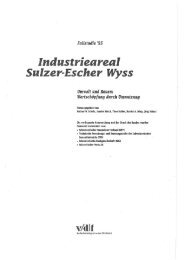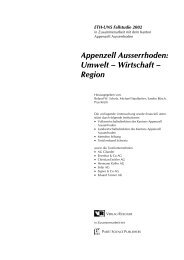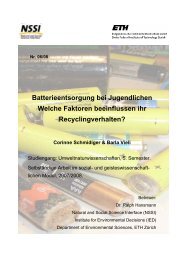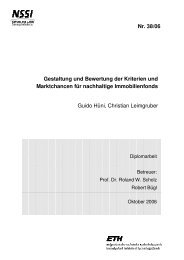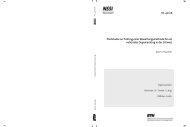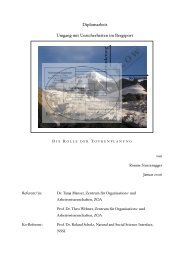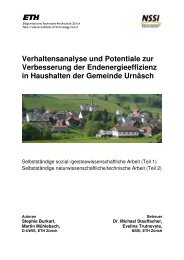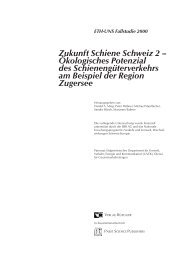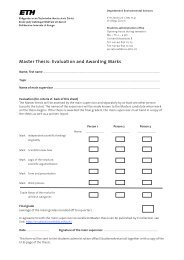Non-road fuel consumption and pollutant emissions ... - BAFU - CH
Non-road fuel consumption and pollutant emissions ... - BAFU - CH
Non-road fuel consumption and pollutant emissions ... - BAFU - CH
Create successful ePaper yourself
Turn your PDF publications into a flip-book with our unique Google optimized e-Paper software.
<strong>Non</strong>-<strong>road</strong> <strong>fuel</strong> <strong>consumption</strong> <strong>and</strong> <strong>pollutant</strong> <strong>emissions</strong> FOEN 2008 90<br />
8.6 Marine machinery<br />
8.6.1 Fuel <strong>consumption</strong><br />
In 2005, the <strong>fuel</strong> <strong>consumption</strong> of ships <strong>and</strong> boats amounted to 36,510 tonnes, with<br />
diesel accounting for 61% (22,170 tonnes) <strong>and</strong> petrol for 39% (14,340 tonnes) (Fig. 46,<br />
top). Commercial operations generate the highest proportion of diesel <strong>consumption</strong>,<br />
which largely corresponds to the <strong>consumption</strong> data provided by major operators for<br />
2005, from which we can estimate the overall <strong>consumption</strong> by Swiss passenger ships:<br />
According to the operators on the lakes of Zurich, Lucerne <strong>and</strong> Geneva, <strong>fuel</strong> <strong>consumption</strong><br />
in 2005 amounted to 3920 tonnes for motor vessels <strong>and</strong> 3400 tonnes for steamships.<br />
These three operators account for 49% (motor vessels) <strong>and</strong> 89% (steamships) of<br />
the mileage of all passenger ships on Switzerl<strong>and</strong>’s lakes. These figures indicate overall<br />
<strong>consumption</strong> in Switzerl<strong>and</strong> of around 8000 tonnes p.a. (motor vessels) <strong>and</strong><br />
3800 tonnes p.a. (steamships), <strong>and</strong> are more or less in line with the results obtained<br />
with the calculation model (9200 <strong>and</strong> 3800 tonnes p.a. respectively) 25 .<br />
The <strong>fuel</strong> <strong>consumption</strong> of steamships is high compared to their proportion of the overall<br />
mileage. This is because the specific <strong>consumption</strong> of these vessels is several times<br />
higher than that of conventional passenger boats.<br />
The level of petrol <strong>consumption</strong> is 14,300 tonnes, 83% of which is attributable to<br />
privately operated boats, while fishing <strong>and</strong> other commercial boats account for the<br />
remaining 17%. The proportion of boats equipped with 2-stroke engines is very low<br />
(2%).<br />
Development of <strong>fuel</strong> <strong>consumption</strong> from 1980 to 2020<br />
In the period under review, the <strong>fuel</strong> <strong>consumption</strong> of ships <strong>and</strong> boats only changed very<br />
slightly, <strong>and</strong> we can expect the figure 15 years from now to be similar to the presentday<br />
level (Fig. 46, bottom).<br />
25<br />
The <strong>consumption</strong> factors for steamships were calibrated on the basis of this plausibility consideration.



